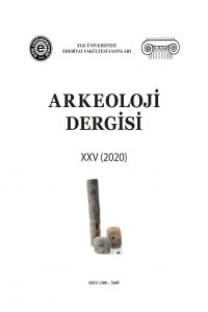Anadolu'da MÖ 3.Binyıl Minyatür Arabaları
Miniture Vehicles in Anatolia during The Third Millennium BC
___
- T. Anlağan, “Sadberk Hanım Müzesi’ndeki Bir Urartu Kemeri Üzerine Gözlemler”, Sadberk Hanım Müzesi Yıllığı, PALMET II, İstanbul, 1998, 51-60.
- F. Edgü (ed.), Anadolu Medeniyetleri, Avrupa Konseyi 18. Avrupa Sanat Sergisi, İstanbul 22 Mayıs-30 Ekim 1983, Ankara, 1983.
- F. Kulakoğlu, “Recently Discovered Bronze Wagon Models from Şanlıurfa, Southeastern Anatolia”, Anatolia, 24, 2003, 63-77.
- M.A. Littauer - J.H. Crouwel, “Early Metal Models of Wagons from the Levant”, Levant, V, London, 1973, 102-126.
- O.W. Muscarella, Bronze and Iron, Ancient Near Eastern Artifacts in the Metropolitan Museum of Art, Newyork, 1988.
- E. Özgen, “A Group of Terracotta Wagon Models from Southeastern Anatolia”, Anatolian Studies, 36, 1986, 165-171.
- O. San, “Diyarbakır Müzesinde Yer Alan İki Adet Pişmiş Toprak Araba Modeli”, Altan Çilingiroğlu’na Armağan Yukarı Denizin Kıyısında Urartu Krallığı’na Adanmış Bir Hayat, İstanbul, 2009, 599-605.
- V. Sevin, “Doğu Anadolu Orta ve Son Tunç Çağı”, Arkeoatlas (Özel Koleksiyon), 2011, 342-367.
- T. Yıldırım, “Eski Hitit Çağına ait Yeni Bir Kült Vazosu”, Anadolu Medeniyetleri Müzesi 2005 Yıllığı, Ankara, 2006, 335-370.
- T. Yıldırım, “Hüseyindede Vazosu”, Aktüel Arkeoloji, 7, 2008, 56-65.
- I. Ziffer, “Four New Belts from the Land of Ararat and the Feast of the Women in Esther 1:9”, Sex and Gender in the Ancient Near East, Proceeding of the 47th Recontre Assyriologique Internationale, Helsinki, July 2-6 2001, Helsinki, 2002, 645-657.
- ISSN: 1300-5685
- Yayın Aralığı: 2
- Başlangıç: 1991
- Yayıncı: Ege Yayınları
Anadolu'da MÖ 3.Binyıl Minyatür Arabaları
Ada Höyük'teki Geç Neolitik/Erken Kalkolitik Mermer Kap Üretimi ile İlgili Arkeolojik Bulgular
Anadolu'da MÖ 3.Binyıl Minyatür Arabaları
Yassı Tepe Höyük Erken Tunç Çağı Potaları
Mehmet Akif ERDEM, Zafer DERİN
Tripolis 2007-2009 kazılarından ele geçen Unguentariumlar Üzerine Bir Değerlendirme
Aytekin ERDOĞAN, Deniz DOĞANALP
Ada Höyük'teki Geç Neolitik/Erken Kalkolitik Mermer Kap Üretimi ile İlgili Arkeolojik Bulgular
Prusias ad Hypium Tiyatrosu - Tonoz Örtülü Galerilere Bakış
Erkan SAĞNAK, Emre OKAN, Ahmet BİLİR
Orta Batı Anadolu’da Kulaksızlar Kazısı Orta Kalkolitik Seramiklerin Bir Değerlendirilmesi
